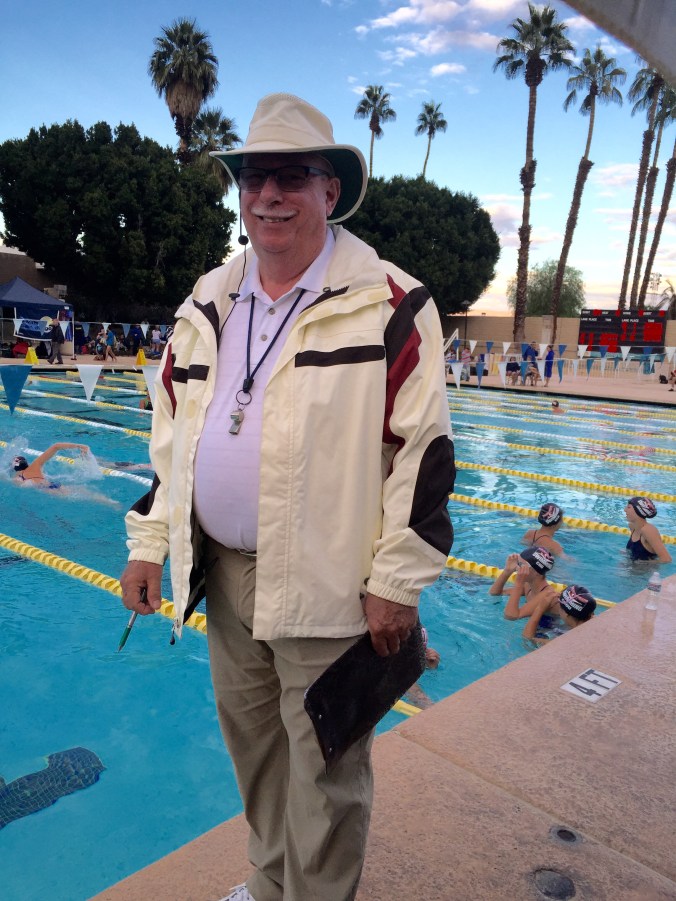
Jack Argue jumped into officiating during the early days of his daughter’s age group swimming career during the 1970s and 80s. “Swimming is the most boring sport in the world to watch, except when your child is swimming,” Jack said. “As they get better, you watch them less and less.” He said there wasn’t a cap on how long a meet could last back then and meets could go on for 10 to 12 hours “and you can only read a newspaper so many times.” He soon discovered that he liked to stay busy waiting to watch his daughter swim for a few minutes.
Herb Hall is the person who got Jack into officiating when his daughter was about seven years old—his daughter Jennifer is now 42. His long-time involvement with swimming started in Hemet, which wasn’t part of US Swimming at the time. He became president of Hemet while his daughter swam there. They switched teams to Palm Springs Piranhas and finally to Redlands Swim Team.
Jack was instrumental in the planning of new pools in Hemet. From 1972 – 78 he was president of the Eastern Section. During the 80s, he was president of the Palm Springs Piranhas when his daughter swam for Head Coach Bill Pullis, prior to Bill’s leaving for Reno. Chuck Riggs was his daughter’s coach in Redlands. Jack’s roles in swimming included being the Officials Chair and a Vice Chair for Southern California Swimming. During this time period, Ed Ruth was the Chairman of Southern California Swimming.
Jack smiled when he reminisced about his days with Herb Hall officiating at the Junior Olympics in Barstow. He said the entire town got behind the meet and the meet would be played on TVs in restaurants throughout the town. He said it was an incredible time and he enjoyed driving Herb around town.
Argue explained that Mary Jo Swalley was the first Executive Director when Southern California Swimming broke away from the AAU and became a US Swimming organization. One of the big things Mary Jo did was take over the travel fund, which has flourished through the years. Under the AAU, there were no funds to send kids to Junior and Senior Nationals in those days. Once the organization of Southern California Swimming was underway, fees were taken from meet fees and put in a rainy day fund for the LSC. He described other roles Mary Jo was responsible for including membership, verifying birth certificates, coaches training, certification, etc. Most people don’t realize that Mary Jo has been in charge of 25,000 athletes, in addition to at least 50,000 parents, 900 coaches and at one time 250 officials.
When asked how things have changed through the years, Jack said there wasn’t as much interaction between the committees as there is today. The sections were autonomous and it was normal to only attend meets in your area until your kids reached the Junior Olympic level. You didn’t have San Diego coming in for a meet, etc. It was pretty much the same swimmers at each meet. Eastern Section went from Palm Springs, Vegas to Walnut. When they had a meet in Vegas, you wouldn’t get a lot of swimmers besides Vegas. In Palm Springs, you’d get Hemet, and Redlands, but not further away. Now there is more interaction between sections.
“Some teams are so big, like Nova with 900 swimmers, that if they sent some of their kids to a meet, they wouldn’t all get in, and neither would any other teams. So they hold their own meets.” Jack said the four-hour rule was passed by the USA Swimming and by people in areas of the country who didn’t have all-day meets. “We had to get creative of how to hold a four-hour meet with 25,000 swimmers,” Jack said.
He recalled an interesting story when there was a push to not let Janet Evans swim high school. “She’s too good,” the high school parents said, “It’s not fair for her to swim, she’s a world record holder.”
Accessibility of facilities is what makes swimming so huge in Southern California Jack said. However, Jack said the East Coast pools are newer and better. He said there is now a push to have meets in pools with seven feet of water and a lot of our pools in Southern California will be absolute. Unless it’s a brand new pool, it won’t be seven feet deep.
When asked about changes to the sport, he said it used to be that parents didn’t have a clue and were on the sidelines and the kids had fun. Early on, there were very few professional coaches where that was their only job. Most coaches were teachers or had another profession. As clubs got bigger they could afford coaches, and that’s been better for the kids.
“A lot of the camaraderie with smaller teams is gone. Kids didn’t jump from club to club. They pretty much stayed close to home. That’s different now.” Jack sites the popularity of the Olympics, the press and exposure that has helped promote swimming dramatically. “The numbers in USA Swimming will go way up during an Olympic year and then drop down until the next Olympics.”
The Argues became a swim family, first because his wife was a former swimmer in Pennsylvania, and then his neighbors had kids on a summer league team and suggested their daughter try swimming, too. Jack Argue and his wife returned to their home in Pennsylvania full-time, but after three years, decided the snowy winters weren’t their cup tea. We now have Jack back in Southern California on the pool deck as an official. They’ll continue to spend their summers in Pennsylvania, stay to see the colors of the leaves change and then return to Southern California and swimming.
Great historical memories of out Southern California Swimming scene. Waiting with great anticipation of the next one.
Thank you for your support Paul. There’s much more to come!